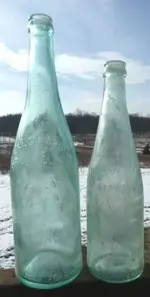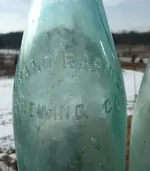Michiganne
Silver Member
- Joined
- Mar 27, 2007
- Messages
- 4,402
- Reaction score
- 550
- Golden Thread
- 0
- Location
- SW Michigan
- Detector(s) used
- Explorer SE
- Primary Interest:
- All Treasure Hunting
- #1
Thread Owner
Hi all:
I have three Grand Rapids Brewing Co. bottles. One I found in a dump and the other two came from excavations around our church. I don't think they're unusually rare but cool nonetheless, as I grew up in G.R. One bottle has a broken neck and I wondered about turning it into a vase of some sorts. Is there any relatively easy way to cut/file the broken neck and make it safe to handle or is this wishful thinking on my part?
TIA for any help,
Michiganne

G.R. Brewing Co. history:
Growing national operations such as Anheuser-Busch Brewing Company took an interest in the thirsty Grand Rapids market and began selling their products in West Michigan.
To counter this growing outside competition, six major local breweries – the Kusterer Brewing Company, Tusch Brothers, George W. Brandt and Co., Veit and Rathamn, Adolph Goetz, and the Frey Brothers – consolidated and, in 1893, the Grand Rapids Brewing Company was officially in business with Charles Kusterer as the president.
The company became the largest beer producer in West Michigan, distributing across Michigan and into surrounding states as well. The Silver Foam brew became their landmark beer, and the company boomed with an output of approximately 600,000 barrels annually, until the temperance movement finally gained traction with a local and national audience.
The movement only gained strength as Americans came to resent German dominance of the beer industry with the entry into World War I, according to Wilhelm Seeger. Some even produced propaganda suggesting that German brewers were secretly aiding the Kaiser.
Michigan voted to go dry May 1, 1918, and the 18th Amendment, which outlawed the sale of alcohol throughout the country, was ratified Jan. 29, 1919. Many brewers such as the Grand Rapids Brewing Company tried to sell soft drinks, “near-beer,” and industrial alcohol products. But Prohibition sounded the death toll for most companies. In 1920, the Grand Rapids Brewing Company sold its three-story production facility and went out of business.
When Prohibition was repealed in 1933, beer quickly became available again in Grand Rapids, initially from larger, out-of-state distributors. The Grand Rapids Brewing Co. opened for a short period, but went out of business by the late 1930's.
I have three Grand Rapids Brewing Co. bottles. One I found in a dump and the other two came from excavations around our church. I don't think they're unusually rare but cool nonetheless, as I grew up in G.R. One bottle has a broken neck and I wondered about turning it into a vase of some sorts. Is there any relatively easy way to cut/file the broken neck and make it safe to handle or is this wishful thinking on my part?

TIA for any help,
Michiganne

G.R. Brewing Co. history:
Growing national operations such as Anheuser-Busch Brewing Company took an interest in the thirsty Grand Rapids market and began selling their products in West Michigan.
To counter this growing outside competition, six major local breweries – the Kusterer Brewing Company, Tusch Brothers, George W. Brandt and Co., Veit and Rathamn, Adolph Goetz, and the Frey Brothers – consolidated and, in 1893, the Grand Rapids Brewing Company was officially in business with Charles Kusterer as the president.
The company became the largest beer producer in West Michigan, distributing across Michigan and into surrounding states as well. The Silver Foam brew became their landmark beer, and the company boomed with an output of approximately 600,000 barrels annually, until the temperance movement finally gained traction with a local and national audience.
The movement only gained strength as Americans came to resent German dominance of the beer industry with the entry into World War I, according to Wilhelm Seeger. Some even produced propaganda suggesting that German brewers were secretly aiding the Kaiser.
Michigan voted to go dry May 1, 1918, and the 18th Amendment, which outlawed the sale of alcohol throughout the country, was ratified Jan. 29, 1919. Many brewers such as the Grand Rapids Brewing Company tried to sell soft drinks, “near-beer,” and industrial alcohol products. But Prohibition sounded the death toll for most companies. In 1920, the Grand Rapids Brewing Company sold its three-story production facility and went out of business.
When Prohibition was repealed in 1933, beer quickly became available again in Grand Rapids, initially from larger, out-of-state distributors. The Grand Rapids Brewing Co. opened for a short period, but went out of business by the late 1930's.







